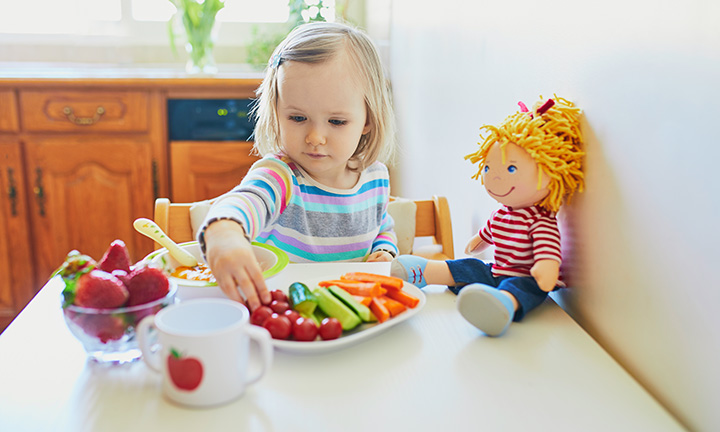
The Art of Feeding a Toddler at 12 to 18 Months
Toddlers are notoriously picky eaters. Starting at the 1-year mark, even previously voracious eaters suddenly seem to lose interest. As they get older, toddlers develop strong opinions about what goes on their plate (and where it is on their plate). Because feeding is at the heart of nurturing, a child's rejection of our carefully prepared food cuts to the core. At such times, it's important to see the big picture. You're teaching your child healthy eating so she can take care of herself over a lifetime. Seeing things from her perspective helps you in this task.
This picky fussiness is normal behavior for 1- to 3-year-olds. Your child is trying to establish her independence and let you know that she wants to take charge of herself. She's also settling into a growth pattern that will lead her toward her genetic body type.
Why Is My 1-Year-Old Eating Less?
At her first birthday, your child is probably more fascinated with learning to walk than with eating. As such, her interest in food plummets: She's just too busy to spend any time eating. But this is normal: Your child grows more slowly in the second year, and her appetite will decrease appropriately. The extra fat she stored in the first year will help fuel this exciting movement. Don't expect any long meals right now.
Still, tots this age need energy to keep going. A 1-year-old can run out of gas quickly and may get frantic or irritable. It's best for her to have five or six small meals throughout the day, including two or three healthy snacks. Give her food in very small portions, adding more if she finishes. A lot of food overwhelms a toddler and just invites her to swipe it all overboard from the high chair or table.
Is My Toddler Eating Enough?
Because it's so hard to pin him down, every bite counts for a busy toddler. Empty calories in cookies, sweets, or juice are a waste of your child's time and appetite. Check out these tips on healthy snacks for toddlers. If you or your healthcare provider thinks your toddler needs to consume more calories, you'll need to look at increasing the nutritional value of every bite rather than increasing the amount he eats. Think about putting an extra spread of butter or cream cheese on toast or a thicker slice of cheese on a muffin, for example.
Offer your child nutritious food at your regular mealtimes as well, but don't force him to eat. Young children who are allowed to decide for themselves when to stop eating grow up to have much healthier eating habits. Your job is to be sure that healthy, appealing foods are offered regularly and in the same eating place. Your child is in charge of whether or not to eat at that time. If he passes once, he'll be hungrier at the next scheduled time.
Please Be Seated
Having your child sit down with you at regular mealtimes, no matter how little he eats, will eventually teach him to eat when meals are served. Toddlers and preschoolers love to eat at the table with the family, and it's the perfect opportunity for them to learn about socializing and table manners. If your child resists or throws food, he's letting you know he's done. Set him down or give him a book to read, but don't coax him to eat more food. It sets up a battle that you can never win.
The Big Mess
Your child learns a lot from "playing" with her food. Dropping food on the floor, squeezing it, and smearing it are all ways she learns about food and how to enjoy eating it. She probably can't use a spoon well, but she should have one anyway, for practice. Toddlers want to feed themselves, and you should encourage it by letting them, no matter how messy they are. Your tot may also be learning how to use a cup; again, this means a lot of spills. Your best option is to learn to live with the mess by using (and wearing) easy-to-clean materials.
Mealtime Tips and Strategies
If your child decides he'll only eat pasta bows, for example, talk to your healthcare provider about whether you should give him a baby vitamin. In general, children don't need extra vitamins, but if your child is really putting up a fight about food, it may help you feel better. Don't give him adult vitamins — they can be toxic to children.
Finally, setting up good eating habits means eating in a regular eating place, such as in a high chair or chair in the kitchen or dining room. It does not mean in front of the TV, in the bedroom, or walking around the house. Toddlers who walk and eat are at risk for choking, as well as long-term bad habits.
Read more about Toddler
Related Articles
Join a World of Support
through Pregnancy and Parenthood.
TRACK WITH TOOLS
LEARN WITH EXPERTS
GET REWARDED








